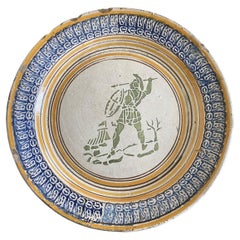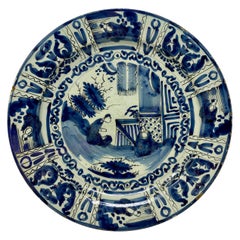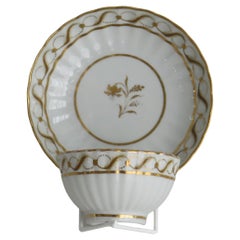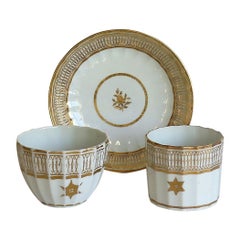Late 18th Century Ceramics
to
27
103
431
1,481
6,956
1,802
954
4,197
1,105
119
41
281
362
208
853
1,121
514
194
72
21
19
16
3
1
1
102
39
33
25
10
53
40
87
45
41
27
13
103
103
103
11
9
8
7
2
Period: Late 18th Century
Italy Late 18th Century Tuscany Ceramic Dish Centerpiece
Located in Brescia, IT
This is an antique piece produced in Tuscany at the end of the 18th Century following the Neoclassical style, mixed to the antique craftmenships of the Tuscany artisans which used ma...
Category
Italian Country Antique Late 18th Century Ceramics
Materials
Ceramic
Antique Delft Tin Glaze Charger, circa 1760-1780
Located in New Orleans, LA
Antique Delft tin glaze charger, circa 1760-1780.
Category
Dutch Antique Late 18th Century Ceramics
Materials
Porcelain
Georgian Derby Trio Tea & Coffee Cup & Saucer Pattern 569, Puce Mark Circa 1795
By Derby
Located in Lincoln, Lincolnshire
This is a good porcelain TRIO of a Tea Cup, Coffee Cup and saucer by the Derby factory, made during the George 111rd period, circa 1795.
The pieces are well potted in the Hamilton...
Category
British George III Antique Late 18th Century Ceramics
Materials
Porcelain
$401 Sale Price / set
31% Off
Fine Georgian New Hall Porcelain Tea Bowl & Saucer Gold Pattern 142, Circa 1785
By New Hall
Located in Lincoln, Lincolnshire
This is a very fine hard paste porcelain Tea Bowl and Saucer by New Hall, dating to the 18th century, George 111rd period, circa 1785.
Both pieces have 24 vertical flutes.
Both pie...
Category
English Georgian Antique Late 18th Century Ceramics
Materials
Porcelain
$313 Sale Price / set
46% Off
John Rose Coalport TRIO Porcelain Gilded Royal Garter Pattern, Circa 1800
Located in Lincoln, Lincolnshire
This is an early porcelain trio comprising a coffee can, tea cup and saucer, all in gilded patterns, which we attribute to Coalport, John Rose & Co., Shropshire, England, made at the...
Category
English George III Antique Late 18th Century Ceramics
Materials
Porcelain
$297 Sale Price / set
49% Off
Early Derby Porcelain Cup & Saucer Rare Pattern 128 Puce Crown Marks, circa 1795
Located in Lincoln, Lincolnshire
This is a late 18th century porcelain Tea Cup and Saucer in pattern 128 by the Derby factory, Circa 1795.
This is a rare Derby pattern that we have not come across or seen previou...
Category
English George III Antique Late 18th Century Ceramics
Materials
Porcelain
$324 Sale Price / set
27% Off
Newhall Porcelain Coffee Can Hand Painted Pattern 683, Circa 1800
By New Hall
Located in Lincoln, Lincolnshire
This is a hard paste porcelain coffee Can by New Hall, dating to the turn of the 18th century, George 111rd period, circa 1800.
The piece is well potted of hard paste porcelain on a low foot with a loop handle having rounded attachments.
The cup is decorated over-glaze with hand painted pattern...
Category
English Georgian Antique Late 18th Century Ceramics
Materials
Porcelain
$187 Sale Price
53% Off
Georgian Coalport Porcelain Trio Hand Painted and Gilded, circa 1790-1800
Located in Lincoln, Lincolnshire
This is an early porcelain trio comprising a vertically fluted coffee can, tea cup and saucer, all in a hand painted and gilded pattern, which we attri...
Category
English Georgian Antique Late 18th Century Ceramics
Materials
Porcelain
$341 Sale Price / set
42% Off
Pair Creamware Vases 18th Century English with Turquoise Trim Circa 1780
By Neale & Co.
Located in Katonah, NY
WHY WE LOVE IT: One of our absolute favorites!
A pair of 18th-century creamware flower holders complete with stands and covers made in England by Neale & Co. was one of the finest 18th century English potteries. The entire composition is classically elegant. The flower holders are decorated with turquoise swags and delicately painted flowers. The tops are pierced for flower stems. The handles are made in a pair of entwined snakes painted in turquoise with bright red mouths. This flower holder could be used with the tops for individual stems or without the tops for a bouquet. All parts of the set have survived and remained together for the past 200 years.
History of Creamware:
Creamware is the name given to a type of earthenware pottery made from cream-colored clays from Dorset and Devonshire combined with calcined flint.
Creamware was first produced in England sometime before 1740. Foremost of the pioneers of creamware in the Staffordshire Potteries was Thomas Whieldon. He produced a wide variety of creamware. The young Josiah Wedgwood was in partnership with Thomas Whieldon from 1754-1759. When Wedgwood left to set up his own business, he immediately directed his efforts to develop creamware. Many of the Staffordshire Potteries, especially Neale & Co., learned from Whieldon and Wedgwood and developed their own excellent creamware products.
Dated: 1795 to 1810 Hanley Staffordshire...
Category
English Neoclassical Antique Late 18th Century Ceramics
Materials
Creamware
George 111rd Porcelain Coffee Can by New Hall Hamilton Flute, circa 1815
By New Hall
Located in Lincoln, Lincolnshire
This is a good, early hand-painted English coffee can, from the late George-III period, of the late 18th Century, circa 1795, which we attribute to ...
Category
English Georgian Antique Late 18th Century Ceramics
Materials
Porcelain
$165 Sale Price
68% Off
Pair Meissen Style Creamware Dishes 18th Century England Hand Painted Circa 1780
Located in Katonah, NY
This is a pair of English creamware dishes from the 18th century, created around 1780. The plates display a lovely chinoiserie scene in the Meissen style, with women selecting access...
Category
English Chinoiserie Antique Late 18th Century Ceramics
Materials
Creamware
Assembled Pair of Wedgwood Cress or Strawberry Dishes, Late 18th C
Located in valatie, NY
An assembled pair of Wedgwood cress or strawberry dishes, Two Piece; Footed Pierced Dish with Stand. Late 18th c. This would have been used to serve watercress or strawberries after ...
Category
English Antique Late 18th Century Ceramics
Materials
Creamware
Wedgwood Creamware Soup Plate with German Ship Decoration.
Located in Downingtown, PA
The ship is flying the flag of the last German Emperor of the Holy Roman Empire, Francis II,
Circa 1775-1790.
The rare Wedgwood creamware plate...
Category
English Georgian Antique Late 18th Century Ceramics
Materials
Creamware, Pottery
Chinese Export Porcelain Handleless Tea Bowl and Saucer, Chinese Imari Pattern
Located in West Palm Beach, FL
Late eighteenth century Chinese Export Porcelain handleless tea bowl and saucer referred to as "Chinese Imari". Hand decorated in iron red, underg...
Category
Chinese Chinese Export Antique Late 18th Century Ceramics
Materials
Enamel
Pair of Vieux Paris Potpourri, 18th Century
Located in Doylestown, PA
A pair of Old Paris porcelain potpourri urns circa 1790 with original lids, hand painted with genre scenes depicting 18th century life, lion mask handles, gilt decoration and a pink ...
Category
French Louis XVI Antique Late 18th Century Ceramics
Materials
Porcelain
Set of 4 French Strasbourg Faience Chargers with Flower Decor
Located in Haddonfield, NJ
Two large French Faience dishes and two smaller from the city of Strasbourg in hand painted floral decoration. They are approximately from around...
Category
French Louis XVI Antique Late 18th Century Ceramics
Materials
Faience
Large Antique English Blue & White Staffordshire or Pearlware Cradle Figurine
Located in Philadelphia, PA
A rare, large English pearlware or Staffordshire pottery cradle.
Decorated with an overall basketweave pattern and blue highlights,
circa 1800.
Measures: Length ca. 5 5/8 in...
Category
English George III Antique Late 18th Century Ceramics
Materials
Pottery
Maiolica flower pot "a mezzaluna," Pasquale Rubati Factory, Milan, circa 1770
Located in Milano, IT
Majolica flower pot "crescent" decorated in manganese
Pasquale Rubati Factory
Milan, c. 1770
4.92 in x 8.66 in x 5,31 in
12.5 cm x 22 cm X 13.5 cm
Weight: 2.29 lb (1039 g)
State of conservation: intact with slight chipping due to use in relief parts
A rare example of a flower pot "a mezzaluna" produced by the manufactory of the refined painter Pasquale Rubati, who opened a factory in Milan in 1756 to compete with Felice Clerici...
Category
Italian Rococo Antique Late 18th Century Ceramics
Materials
Maiolica
Italian, Late 18th Century Watch Holder with Father Time
Located in valatie, NY
Italian, late 18th century watch holder with Father Time. The robed figure of Father Time is standing on a raised plinth with rocks and a koi fish or carp....
Category
Italian Antique Late 18th Century Ceramics
Materials
Ceramic
Italian Maiolica Tureen, Rubati Manufacture, Milan, circa 1770-1780
Located in Milano, IT
Maiolica tureen
Pasquale Rubati Manufacture
Milan, circa 1770 - 1780
Maiolica polychrome decorated “a piccolo fuoco” (third fire).
It measures 6.69 in x 11,02 x 8.26 (17 x 28 x ...
Category
Italian Rococo Antique Late 18th Century Ceramics
Materials
Maiolica
Four Italian Ancient Dishes, Antonio Ferretti, Lodi, circa 1770-1780
Located in Milano, IT
Assortment of 4 dishes with braided rim
Antonio Ferretti Manufacture
Lodi, circa 1770-1780
Maiolica polychrome decorated “a piccolo fuoco” (third fire).
Measures: 14 x 10 in (35.5 x 25.5 cm);
12.2 x 8.39 in (31 x 21.3 cm);
10.4 x 9.65 in (26.5 x 24.5 cm);
10.8 x 9.61 in (27.5 x 24.4 cm).
Weight: 4.4 lb (1.998 kg)
State of conservation: some chips due to use on the edges and on the parts in relief.
The four different dishes have a foot with a low lip from which extends a wide, flat, slanted rim resembling a basket weave. The small handles are painted green: they resemble wickerwork in the two oval dishes and take the form of a sinuous branch in the round ones.
The third fire decoration is inspired by the naturalistic floral botanical patterns on the ceramics produced by the Hannong family in Strasbourg. Here the pattern is defined by the rapidity and subtlety of the brushstrokes and the result is particularly tasteful, characterized by compositional intelligence and pictorial expertise.
A main corolla, either a wild or garden rose, is set slightly off center in each well. From this extends a thin stem holding a small secondary bud and there are small field florets dotting the composition to lend volume to the delicate bunch of flowers.
On the brim, small polychrome flowers add color to the weave, accompanied by lanceolate leaves of a very intense green.
There exist few and very rare examples for comparison with this morphology: a round plate - entirely consistent with those in question - has been dated to around 1775 (S. Levy, Maioliche settecentesche lombarde e venete, Milano 1962, tav. 200). Two other dishes with a basket rim, but with parallel striped brim decoration, were exhibited in the 1995 exhibition on Lodi ceramics; the attribution to the Lombard town near Milan is therefore almost exclusively derived from the decoration called "alla rosa contornata" or "alla vecchia Lodi" and constitutes one of the most popular decorations during the eighteenth century. (M. L. Gelmini, in Maioliche lodigiane del '700 (cat. mostra Lodi), Milano 1995, pp. 31 p. 162-163 nn. 181-182).
This decorative choice represented a strong point of the Lodi factory, which established itself thanks to the vivid nature of the colors made possible by the introduction of a new technique perfected by Paul Hannong in Strasbourg and which Antonio Ferretti introduced in Italy. This production process, called “piccolo fuoco” (third fire), allowed the use of a greater number of colors than in the past; in particular, the purple of Cassius, a red made from gold chloride, was introduced. Its use allowed for many more tones and shades, from pink to purple.
The Ferretti family had started their Maiolica manufacturing business in Lodi in 1725.
The forefather Simpliciano had started the business by purchasing an ancient furnace in 1725 and, indeed, we have evidence of the full activity of the furnaces from April of the same year (Novasconi-Ferrari-Corvi, 1964, p. 26 n. 4). Simpliciano had started a production of excellence also thanks to the ownership of clay quarries in Stradella, not far from Pavia. The production was so successful that in 1726 a decree of the Turin Chamber came to prohibit the importation of foreign ceramics, especially from Lodi, to protect internal production (G. Lise, La ceramica a Lodi, Lodi 1981, p. 59).
In its initial stages, the manufacture produced maolicas painted with the “a gran fuoco” (double fire) technique, often in turquoise monochrome, with ornamentation derived from compositional modules in vogue in Rouen in France. This was also thanks to the collaboration of painters like Giorgio Giacinto Rossetti, who placed his name on the best specimens next to the initials of the factory.
In 1748 Simpliciano made his will (Gelmini, 1995, p. 30) appointing his son Giuseppe Antonio (known as Antonio) as universal heir. After 1750, when Simpliciano passed away, Antonio was directly involved in the Maiolica factory, increasing its fortunes and achieving a reputation on a European level. Particularly important was the aforementioned introduction in 1760 of the innovative “a piccolo fuoco” (third fire) processing, which, expanding the ornamental repertoire with Saxon-inspired floral themes, could commercially compete with the German porcelains that had one of its most renowned offerings in the naturalistic Deutsche Blumen. Antonio Ferretti understood and promoted this technique and this decoration, proposing it in a fresher and more corrective version, less linked to botanical tables...
Category
Italian Neoclassical Antique Late 18th Century Ceramics
Materials
Maiolica
Chinese Export Porcelain Blue Fitzhugh Oval Platter and Mazarin
Located in Downingtown, PA
Chinese export Blue Fitzhugh very large porcelain blue Fitzhugh oval platter and Mazarin,
Late 18th-early 19th century.
The remarkably large serving di...
Category
Chinese Chinese Export Antique Late 18th Century Ceramics
Materials
Porcelain
Small Maiolica Flower Pots, Ferretti Manufacture, Lodi, circa 1770-1780
Located in Milano, IT
Two maiolica flower pots
Antonio Ferretti Manufacture
Lodi, Circa 1770 - 1780
Maiolica polychrome decorated “a piccolo fuoco” (third fire)
The...
Category
Italian Rococo Antique Late 18th Century Ceramics
Materials
Maiolica
Ancient Maiolica Flower Pot Pasquale Rubati Factory, Milan Circa 1770
Located in Milano, IT
Maiolica flower pot “a mezzaluna” decorated with tulip
Pasquale Rubati Factory
Milan, circa 1770.
Measures: 4.7 in x 4.7 in x 8.6 in
12 cm x 12...
Category
Italian Rococo Antique Late 18th Century Ceramics
Materials
Maiolica
Ancient Italian Maiolica Rose Dishes by Pasquale Rubati Milano, 1780 circa
Located in Milano, IT
Assortment of 12 elements with polychrome and gold decoration
Pasquale Rubati Factory
Milan, circa 1770- 1790.
Two oval trays 10.62 in x 8.58 in (27 x 21.8 cm)
Two dishes with perforated brim diameter 10.43 in (26.5 cm)
Eight round dishes 9.37 in (23.8 cm)
lb 10.14 (kg 4.6)
State of conservation: very good, except for light chips with color drops at the edges, a greater one in a round dish.
This rare set of dishes has great decorative impact and confirms the undisputed artistic ability of Pasquale Rubati's productions during the period of his greatest success. It also attests to the taste of the great Milanese commissions of the eighteenth century.
Pasquale Rubati, a refined painter, opened his own factory in Milan in 1756, in competition with Felice Clerici...
Category
Italian Rococo Antique Late 18th Century Ceramics
Materials
Maiolica
Basket-Weave Teapot in Black Basalt, Wedgwood C1790
By Wedgwood
Located in Melbourne, Victoria
A most attractive and unusual teapot in black basalt, moulded with basket-weave decoration and interlocking arches.
Exhibited: Wedgwood, Master Potter ...
Category
English Neoclassical Antique Late 18th Century Ceramics
Materials
Stoneware
Rococo Italian Maiolica Flower Pot Pasquale Rubati, Milano, 1770 circa
Located in Milano, IT
Maiolica flower pot “a mezzaluna” with support feet
decorated with little bunches of flowers
Pasquale Rubati Factory
Milan, circa 1770
5.5 in X ...
Category
Italian Rococo Antique Late 18th Century Ceramics
Materials
Maiolica
Ancient Maiolica Coffee Set “Barbotine” Decoration Milan, 1770- 1780
Located in Milano, IT
Coffee assortment with “barbotine” decoration
Manufacture of Pasquale Rubati or Felice Clerici
Milan, 1770- 1780
Maiolica polychrome decorated “a piccolo fuoco” (third fire).
...
Category
Italian Rococo Antique Late 18th Century Ceramics
Materials
Maiolica
Antique Italian Maiolica Coolers Pasquale Rubati Manufacture Milan, 1770 Circa
Located in Milano, IT
Assortment of bottle and glass coolers in Maiolica.
Pasquale Rubati manufacture
Milan, circa 1770
Maiolica polychrome decorated “a piccolo fuoco” (third fire)
a - Bottle cooler
5.91 in x 5.91 in diameter (15 x 15 cm )
Weight: 1.86 lb (845 g)
b - Bottle cooler
6.89 x 7.87 in diameter (17,5 x 20 cm)
Weight: 2.09 lb (948 g)
c - Pair of glass-cooler vases
3.94 x 3.94 in diameter (10 x 10 cm)
Weight: 1.43 lb (650 g)
Good state of conservation:
a - some chipping from use on the edge;
a - two fêlures covered on the edge;
c - one has deep chippings on the edge and the other a subtle fêlure.
Two Majolica factories were active in Milan in the 18th century. The first, starting from 1745, was owned by Felice Clerici; the other one by Pasquale Rubati from 1756. Rubati was in competition with Felice, whose worker he had been prior to opening his own workshop. On his death in 1796, the business was continued for a few more years by his son Carlo.
Recent studies have recognized Pasquale Rubati's contribution as the creator of "Strasbourg-style" decorations with their particularly joyful depictions. This style had previously been attributed to the Lodi manufacturers. These works here, however, are a clear example of this production.
The Majolica containers have different sizes, a cylindrical shape and rest on a low foot ring. The two largest are completed by handles in the shape of a zoomorphic mask with wide open jaws, while the smaller ones have handles applied with an anthropomorphic mask.
All the works are characterized by elegant floral decoration.
The two twin glass coolers show bunches of flowers centered around a main corolla, a rose or a peony paired...
Category
Italian Rococo Antique Late 18th Century Ceramics
Materials
Maiolica
Maiolica Oval Tray, Felice Clerici Manufactory, Milan, Circa 1770-1780
Located in Milano, IT
Small oval tray
Felice Clerici Manufactory 1745-1780
Milan, Circa 1770-1780
Maiolica polychrome.
Dimensions: 10.82 x 8.66 in (27.5 x 22 cm); weight 0.4...
Category
Italian Rococo Antique Late 18th Century Ceramics
Materials
Maiolica
Circa 1780 Chinese "Elephant & Mahout" Vegetable Dish
Located in Chapel Hill, NC
Circa 1780 Chinese export "elephant & mahout" oval vegetable dish. Qing dynasty, Qianlong period. Retailed by Sarah potter conover, early label. One of ...
Category
Chinese Qing Antique Late 18th Century Ceramics
Materials
Ceramic
$400 Sale Price
46% Off
Pair of Ancient Italian Maiolica Flower Pots Milan, Rubati Factory, 1770 circa
Located in Milano, IT
Maiolica flower pot “a mezzaluna”
decorated with trompe l’oeil
Pasquale Rubati Factory
Milan, circa 1770
Measures: each 4.7 in (cm 12) x 5 in (c...
Category
Italian Rococo Antique Late 18th Century Ceramics
Materials
Maiolica
Italian Maiolica Flower Pot Garlands of Flowers, P. Rubati, Milano, 1770 circa
Located in Milano, IT
Maiolica flower pot “a mezzaluna”
decorated with garlands of flowers
Pasquale Rubati Factory
Milan, circa 1770
Measures: 4.7 in x 5 in x 8.8 in
...
Category
Italian Rococo Antique Late 18th Century Ceramics
Materials
Maiolica
Black Basalt Teapot with Enamel Decoration, Probably Spode C1800
By Josiah Spode
Located in Melbourne, Victoria
Globular teapot in black basalt, painted with matt white, red and ice blue. Judging by the shape and general appearance, probably by Spode, in imitation of Wedgwood designs of the pe...
Category
English Neoclassical Antique Late 18th Century Ceramics
Materials
Stoneware
Mounted Imari Porcelain Perfume Fountain
Located in PARIS, FR
Perfume fountain in porcelain Imari kinrandé mounted in gilt bronze from the same set of porcelain. The cup and the bowl form the base, the pot covers the perfume container...
Category
Chinese Antique Late 18th Century Ceramics
Materials
Bronze
Antique English Late 18th Century Yorkshire or Staffordshire Basket
Located in CHARLESTON, SC
Rare antique English Yorkshire or Staffordshire creamware pierced basket with intricate reticulated body. Lovely color no damage or repairs.
Category
English Antique Late 18th Century Ceramics
Materials
Creamware
Pair of Vienna Green Ground Ice Pails, circa 1780
Located in New York, NY
With covers and liners. Marked with under glaze blue shield mark.
Category
Austrian Antique Late 18th Century Ceramics
Materials
Porcelain
Mixed Clay Ewer with Classic Decoration and Swan Handle Grammont Factory Orleans
By Grammont Ainé
Located in Argenteuil, IDF
Rarely ewer in mixed clay from the Orleans factory of Grammont Ainé(1764-1832)
End of the 18th century, around 1790
Very beautiful & rare zoomorphic ewer in earthenware mixed with ...
Category
French Louis XVI Antique Late 18th Century Ceramics
Materials
Ceramic
Hand-Painted Ceramic Jug with Lead Lid, Dated From 1762,
Located in Marbella, ES
Hand-Painted ceramic jug with lead lid, dated from 1762, initials G. and R. and signed at the bottom, with scenes of windmills and a house.
Category
Dutch Antique Late 18th Century Ceramics
Materials
Lead
Pair of English Porcelain Mini Cabbage Leaf Jugs, circa 1785
Located in New York, NY
With mask spout the sides moulded with upright leaves and painted with insects, foliated capped handle.
Category
English Antique Late 18th Century Ceramics
Materials
Porcelain
Late 18th Century Terre De Namur Core Piece, Coffee Tee & Milk, Belgium
Located in Vienna, AT
3-part core piece consisting of coffee pot, teapot and milk jug made of Terre de Namur ceramics.
Terre de Namur
The fine black faience is a particular product of Namur, Belgium, lat...
Category
Belgian Baroque Antique Late 18th Century Ceramics
Materials
Porcelain
Pair of Triton Candlesticks. Palmer C1780.
By Palmer
Located in Melbourne, Victoria
An exceptionally rare pair of Triton candlesticks, in black basalt with gold lustre. The design is copied from Wedgwood, who took it from Sir Willi...
Category
English Neoclassical Antique Late 18th Century Ceramics
Materials
Stoneware
$6,000 Sale Price
20% Off
Navette, with Ladle, Wedgwood, C1790
By Wedgwood
Located in Melbourne, Victoria
An extraordinary navette, or cream boat, in black basalt with encaustic decoration. Complete with matching ladle: a rare find indeed.
Category
English Neoclassical Antique Late 18th Century Ceramics
Materials
Stoneware
Recently Viewed
View AllMore Ways To Browse
19th Century Spanish Large Granada Fajalauza
Aspic Mold
Axel Salto Bowl With Sung Glaze
Bear Cookie Jar
Bitossi Arabesque
Ceramic Mermaids
Ceramic Tennis Set
Ceramic Toast Rack
Chinese Sweet Meat
Chris Gustin
Corning Ware
Dansk Coffee Pot
Deldare Buffalo
Egg Pol Chambost
Eva Zeisel Museum
Faience Stein
Flintstone Cookie Jar
Fornasetti Fiat





